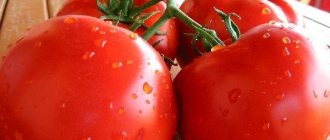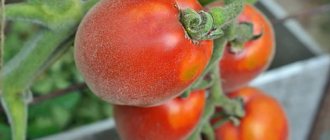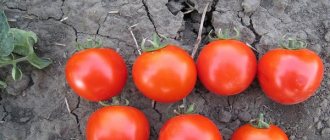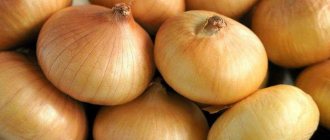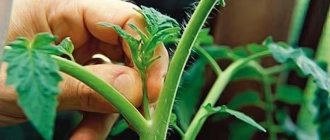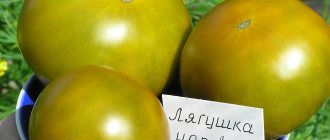Description of the Lyubasha variety
The hybrid tomato Lyubasha was received quite recently, in 2016, by Russian agro breeders. Since 2022, the variety has been included in the State Register and is recommended for cultivation in open ground and in greenhouses throughout Russia.
The hybrid belongs to early ripening tomatoes and is characterized by excellent taste. From the emergence of seedlings to harvest, only 70–85 days pass (taking into account possible changes in ripening times in different climatic conditions).
Tomato Lyubasha on video
Varietal characteristics
Lyubasha is an early determinate hybrid. It takes 70 days from germination to fruit appearance. Fruiting is uniform, 7-8 tomatoes are formed on simple inflorescences. The first brush is laid after the 5th sheet.
Lyubasha tomatoes are resistant to:
- cracking,
- late blight.
When growing a crop with 3 stems and placing 5 plants per 1 m², the yield is:
- 14-15 kg – in a film greenhouse;
- 10-11 kg – in open ground.
Compared to the characteristics and descriptions of other tomato varieties and early hybrids, Lyubasha has a number of advantages; it is easy to grow even for novice gardeners.
Appearance of plants
Lyubasha is a determinate tomato, that is, it is limited in growth. The maximum “growth” of the bushes is 1 m. The plants are compact and oval in shape. The stems are strong, which allows them to withstand the weight of the harvest well. The number of leaves on the bushes is average, the leaf sizes are small, the color is dark green. The inflorescences are simple; each bush usually produces 4–5 fruit clusters.
The fruits are medium in size (average weight 120–140 g), characterized by a round, slightly flattened shape and medium ribbing. The skin is smooth and glossy, quite dense, so the tomatoes do not crack even in rainy weather.
Lyubasha bushes do not grow too large
At the stage of technical ripeness, the skin has a soft green color, and when fully ripe, it is rich, bright red. The pink pulp is characterized by medium density and high juiciness. Each fruit has 3–4 fairly large (compared to other hybrid tomatoes) seed chambers, but the total number of seeds is not too large.
Tomato sizes reach 6–7 cm, and the number of large seed chambers is usually 3
The juice and pulp contain a large amount of vitamins B, C, PP, as well as potassium, phosphorus and other useful elements. The content of ascorbic acid is as high as in citrus fruits and black currants. Consumption of fresh tomatoes is recommended to improve metabolism and as a support for anemia, cardiovascular diseases, memory impairment and other diseases.
The taste of Lyubasha tomatoes receives high marks from experts. A bright aroma is also noted, especially when cutting the fruit.
Farmer reviews
Despite its short lifespan, the variety has managed to attract the attention of many vegetable growers. The new hybrid meets all the basic requirements and is quite capable of competing with crops that have proven themselves in the tomato world.
It is quite possible that in the near future the variety will begin to be widely used on an industrial scale, deriving decent profits from it. But for now, experiments with the young hybrid are taking place in summer cottages.
Let's get acquainted with the opinions of gardeners:
Tatyana, Orel: “The weather this year was not tomato-like at all, cold and rainy. Many varieties were destroyed by late blight, but the hybrid survived. The vegetables turned out delicious, and now I’ll be stocking up all winter. It’s very good that I planted this variety, otherwise I would have been left without tomatoes.”
Elena, Kursk: “A completely normal variety. I didn’t prune and didn’t water often. But there were tomatoes. The taste is quite satisfactory, typical for tomatoes, with sourness. The skin is dense, perfect for blanks. It’s a pity that you can’t prepare the seeds yourself. Will have to buy again. Thank God the price is affordable.”
Dinara, Krasnoyarsk: “The variety sprouted with difficulty, the bushes are modest, with 2-3 fruiting clusters. But we survived our cold summer. There were few vegetables. I don’t even know if I’ll plant it next year.”
Advantages and disadvantages, features, differences from other varieties
Despite its recent history, the Lyubasha tomato often receives praise from gardeners due to a number of advantages such as:
- early germination and very early ripening;
- high yield (2–2.5 kg per bush in open ground and up to 4 kg in a greenhouse or 8–10 kg/m2 and 15–20 kg/m2, respectively);
- resistance to the vagaries of weather and lack of care;
- no need to regulate growth;
- good resistance to pests and diseases (in particular, late blight, tobacco mosaic and gray rot);
- possibility of transportation and long-term storage due to the thick skin;
- good taste (rare for early types of tomatoes);
- versatility of use (good for both canned food and fresh consumption).
Flaws:
- poor resistance to prolonged temperature drops;
- uneven fruit size: the first tomatoes reach a weight of 200 g, and then become smaller;
- the need for tying (despite limited growth) and pinching;
- simultaneous ripening of the crop, which does not allow you to enjoy fresh fruits for a long time.
Unlike most other varieties, Lyubasha does not require fertilizing during the growth period.
There are a lot of early varieties and hybrids of tomatoes, so for comparison with the Lyubasha hybrid, we will consider only a few of them.
Table: comparative characteristics of the Lyubasha hybrid and some other early varieties of tomatoes
| Index | Name of variety/hybrid | ||||||
| Lyubasha | Alpha | Aphrodite F1 | Benito F1 | Greenhouse early ripening F1 | golden brush | Legionnaire F1 | |
| Ripening time | 70–75 days | 87–96 days | 75–80 days | 95–113 days | 80–90 days | 95–98 days | 90–95 days |
| Height | up to 100 cm | 40–50 cm | 50–70 cm | 40–50 cm | Up to 70 cm | Up to 150 cm | 45–60 cm |
| Fruit size | 110–130 g | 50–70 g | 110–115 g | 120 – 140 g | 120–180 g | 20–30 g | 140–150 g |
| Productivity | Up to 15 kg/m2 | Up to 6.5 kg/m2 | Up to 17 kg/m2 | Up to 25 kg/m2 | Up to 15 kg/m2 | Up to 6.5 kg/m2 | Up to 17 kg/m2 |
| Preferred growing method | greenhouse/open ground | greenhouse/open ground | greenhouse/open ground | greenhouse/open ground | greenhouse | greenhouse | greenhouse/open ground |
| The need to prepare seedlings | required | not required | required | required | required | required | required |
| Main advantages | Unpretentiousness to growing conditions, resistance to blossom end rot | Undemanding to heat and light, minimum requirements for agricultural technology | shelf life, transportability, increased resistance to fungal diseases | resistance to verticillium wilt and fusarium, shelf life | stable yield, resistant to verticillium and fusarium | great taste | no fruit cracking, increased resistance to tobacco mosaic virus |
| Purpose | universal | salad | universal | universal | universal | universal | salad |
Lyubasha grows and develops well in open ground, in greenhouses and even on the balcony of a city apartment. It should be borne in mind that the greatest yield can be obtained in greenhouse conditions.
Advantages and disadvantages
| pros | Minuses |
| High yield | Inability to collect your own seeds |
| Pleasant taste | Garter required |
| Uniform ripening | |
| Smooth fruits of equal size | |
| Universal use in cooking | |
| Disease resistance | |
| Long fruiting | |
| Drought resistance | |
| Cold resistance | |
| Unpretentiousness | |
| Marketability | |
| Keeping quality | |
| Transportability |
Features of planting and growing tomato Lyubasha
Although Lyubasha is an early variety, it is usually grown as seedlings. Direct sowing into the ground is possible only in the southern regions.
The timing of sowing seeds for seedlings depends on the climatic conditions of the region and can range from mid-February to mid-March. The appropriate time for sowing is calculated based on the need to transplant the seedlings to a permanent place approximately 40–45 days after seed germination. It should be taken into account that planting in the ground can only be carried out after the end of the recurrent frost season.
Preparing seedlings
Before planting, Lyubasha tomato seeds need to be treated to prevent diseases. They are poured with a weak solution of potassium permanganate for 2–3 minutes, and then washed with warm water.
Step-by-step procedure for sowing seeds:
- Preparing containers: pots, boxes, cassettes, cups, peat tablets and even plastic bags are suitable for growing seedlings. They are filled with turf soil, peat mixtures or soil with humus.
- The soil is shed with warm water 1 day before planting.
- Make 1–1.5 cm depressions in the soil and plant the seeds. When row sowing in long boxes, the distance between adjacent holes should be 3–4 cm. When planting in separate pots, 2 seeds are placed in each hole.
- The seeded containers are covered with plastic film (it is convenient to use food stretch film) and placed in a warm (temperature +23...+25 °C), well-ventilated room.
- The film is removed from the crops after germination. From the second week of life, the plants need to be moved to a cooler room with a temperature of 19–20 degrees.
When sowing, follow the following procedure: 1 - disinfect the seeds with potassium permanganate; 2 - select containers and fill them with moist nutrient soil; 3 - plant seeds to a depth of 1–1.5 cm; 4 - cover the crops with film
They care for hybrid seedlings in the same way as seedlings of other tomato varieties. One of the points is the duration of daylight hours: 10–12 hours (adjustable using additional lighting).
Phytolamps provide the light spectrum necessary for plants
You need to water young tomatoes once a week at first (the frequency of watering is controlled by the degree of drying of the soil), and after 3 weeks of growth you need to switch to moderate watering every 4-5 days. Tomatoes cannot tolerate extreme waterlogging, so you need to be careful not to overwater the plants.
When young plants have a second true leaf, you should pick (for Lyubasha it is best to do this without tearing off the main root) in a larger container, for example, in pots with a volume of 0.5–0.7 liters.
A distinctive feature of the Lyubasha hybrid is that it does not require fertilizing during the seedling growth stage. If there are doubts about the quality of the soil used, you can add a little phosphorus-potassium or complex fertilizers with irrigation water.
Planting in open ground
After about 1.5 months from the moment of germination, the seedling bushes usually grow to 20–25 cm in height, already have a fairly strong stem and 7–9 leaves. As a rule, by this time the first flower raceme has already formed. In this state, seedlings can be planted in open ground or in a greenhouse. Transplantation can be carried out only when the threat of night frosts has passed. This usually happens at the end of May.
For tomato beds, you need to choose the sunniest place on the site that is illuminated for the longest possible time. Almost any soil is suitable - Lyubasha is not too picky.
When planting, it is often recommended to place fertilizer in the holes. If you do this, the tomatoes will only grow greens. Therefore, adding organic matter and urea to the wells is not recommended. It is better to use potassium salts or ash.
The planting density of Lyubasha tomatoes should be 4–6 bushes per square meter (the interval between neighboring plants is 30–40 cm). To prevent the bushes from falling to the ground during fruiting, it is better to immediately tie them to stakes.
Plant care
Lyubasha is not capricious and does not require special care techniques. Still, to ensure a good harvest, it is necessary to carry out such standard operations as weeding, hilling, watering, forming bushes, fertilizing, and disease prevention.
Formation of bushes
Due to the fact that Lyubasha is limited in growth, it does not need to be pinched: a fruit cluster is formed at the top of the main shoot. Although the bushes are not very tall, they require staking and pinching (removal of side shoots).
Optimal yield indicators are achieved when Lyubasha bushes are formed into 2–3 stems (with dense planting 2 stems, with sparse planting - 3).
Recent Entries
Lilac perennials that are beautiful, compact and do not crowd out other plants Why when buying seedlings you should not take the sellers’ word for it and how to determine the age of the plant using 3 signs Tomato seedlings have turned purple or whitish: why the color has changed and how to save the plants
When growing a plant with 2 stems on the bush, leave the main shoot and one side shoot growing under the first flower raceme. The remaining side shoots must be removed regularly.
When forming 3 stems, they act in a similar way, but leave another one growing above the first flower raceme.
Forming tomatoes - video
It should be noted that in warm southern regions a larger number of stepchildren can be left.
As the bush grows, it needs to be tied up. Despite the strength and thickness of the stems, the bushes can break during fruit ripening, since a feature of the hybrid is the simultaneous ripening of tomatoes. For gartering, you can use rigid trellises, stakes, and twine.
Tying tomatoes - photo
Twines are most convenient to use in a greenhouse, but they can also be used for planting in open ground. Stable and durable structures will provide reliable support for bushes
Providing each plant with an individual support stake is a labor-intensive process
Top dressing
Lyubasha tomatoes do not need to be fed before planting in the ground (although, if desired, phosphorus, magnesium, and potassium compounds can be added already in the first week of growth).
Typically, manure is considered the best fertilizer for garden crops. For tomatoes, including Lyubasha, manure and bird droppings should not be used. Experienced gardeners prefer to use only mineral fertilizers when growing tomatoes: Fitosporin, Glyokladin, Kristalon, Lignohumate, Boroplus. Ash is an excellent folk remedy. Feeding is carried out several times per season.
The author’s personal experience in growing tomatoes shows that to prevent plants from fattening, it is very useful to give them “stress.” As soon as the bushes begin to grow vigorously, gently reduce watering or remove one or two lower leaves. Such measures force plants to direct their energies to laying flower clusters and forming fruits. In addition, care must be taken with fertilizing. After planting, you should not feed tomatoes with nitrogen (unless there is a clear deficiency). It is advisable to give the first root fertilizing (and potash) only at the time of flowering of the 5th–6th cluster. Foliar feeding with solutions of magnesium and other microelements works well on plants. Fruits ripen better and faster in soil poor in organic matter. Therefore, when preparing the soil, you should not get carried away with organic matter, and during planting, you should not put manure in the holes. In addition to fattening, excess organic matter provokes late blight diseases in tomatoes. In general, it is better to grow tomatoes under-fed than over-fed. Mullein solution should not be used more than 2-3 times per season.
If there is an excess of nutrients, tomatoes can very easily begin to fatten. To prevent this from happening, you can take the following steps:
- The soil should not be too nutritious. Even in autumn, it is not recommended to add manure to the soil.
- Tomatoes should not be watered for the first 2-3 weeks after planting (especially if planted early). Rooting of seedlings will be ensured by water poured into the holes. Further restriction of watering promotes active development of the root system. It is strictly forbidden to overdry the soil - the flowers may fall off, so care must be taken when limiting watering.
- Do not feed tomatoes with nitrogen fertilizers during the entire growing season.
Watering plants
Tomatoes require regular soil moisture for full growth and fruit formation, especially in hot weather. Watering should be carried out strictly at the root in the evening or early morning. The best option is to use drip irrigation.
You can organize drip irrigation of tomatoes yourself
The recommended regime for Lyubasha tomatoes is watering every 5-7 days, and in extreme heat - every 3-4 days. The moisture supply rate is 4.5–5 liters per bush. More frequent and too abundant watering will only harm the plant.
Frequent, moderate watering of tomatoes provokes the growth of a superficial root system, which reduces the plant's resistance to adverse external factors.
Watering should be stopped 2–2.5 weeks before harvesting the fruits.
Protecting tomatoes from diseases and pests
Despite Lyubasha’s high resistance to diseases and pests, there is always a risk that the plants will get sick. The simplest means of prevention are:
- compliance with crop rotation requirements;
- timely elimination of weeds and plant debris from the site;
- plant tomatoes away from beds with eggplants and potatoes;
- maintaining distance between bushes.
Biological preparations Alirin or Gamair are well suited for the prevention and treatment of fungal and bacterial diseases.
To repel pests, it is recommended to plant marigolds around tomato beds.
How to care outdoors?
Caring for these tomatoes is no different from agricultural techniques for other varieties: watering, fertilizing, forming a bush.
How to water correctly?
Tomatoes are watered regularly and abundantly. The next watering is needed as the top layer of soil dries out. The procedure should be carried out in the evening, after sunset, or early in the morning.
How to fertilize?
Lyubasha tomatoes respond well to organic matter and mineral fertilizers. The first fertilizing after planting is applied three weeks later. To do this, manure is diluted with water in a ratio of 1:10. A glass of the life-giving mixture should be poured under each bush.
The second fertilizing is applied at the moment of fruit set. During this period, they are fed with complex mineral fertilizers. The third fertilizing is applied after 2 weeks.
Bush formation
There is an opinion that determinate varieties should not be formed and stepsons should not be removed. Removing stepchildren will allow the inflorescences and fruits to receive more micro- and macroelements.
See also
Description and characteristics of the White Naliv tomato variety, yield and cultivation
Read
The formation of the bush begins at the moment the first brush appears:
- All stepsons 5-7 centimeters high below the first inflorescence are removed.
- In place of the stepson, a stump of 2-3 millimeters is left. This is to prevent a new sprout from appearing in the same place.
- Tomatoes are inspected 2 times a week. New stepsons are removed.
- As soon as two inflorescences appear, there are no leaves between them - this is a signal that the bush will no longer stretch upward.
- If the task is to grow a tomato with 2 stems, then one stepson is left under the inflorescence.
- It forms a secondary shoot.
- Leaves, stepsons, and inflorescences will appear on it. Stepchildren are also removed.
- On 2 brushes of the secondary stem, pinch after the leaf that grows above the brush.
- When tasked with growing a tomato into three stems, two stepsons are left under the inflorescences.
- The strongest ones are chosen. Also, when 2 brushes appear, pinching is done.
- The lower leaves up to the raceme are gradually removed down to the inflorescence.
If fruits have already formed on the cluster, and the remaining shoots are just blooming, they must be removed. They will pull nutrients, reduce the fruits, and will not be able to catch up with them.
Collection, storage and use of crops
Fruits can begin to be collected in the last ten days of June - early July. Thanks to their rapid ripening, they can be cut in whole bunches.
Tomatoes ripen in clusters, making harvesting easier
The collected tomatoes should be stored in a cool, dark room at a temperature of 10–12 °C and regularly ventilated. Under such conditions, unripe fruits can be stored for about 2–2.5 months. Fruits picked ripe retain their quality in the refrigerator for up to 1 month.
Thanks to their good taste, Lyubasha tomatoes can be used both in salads and for various preparations. The small size of the fruits makes pickling convenient. They also make very tasty juice, excellent adjika and other sauces. Lyubasha tomatoes can even be dried.
Thanks to their dense pulp, Lyubasha tomatoes dry well
Flaws
Despite numerous positive characteristics, the Lyubasha variety also has disadvantages:
- low tolerance to prolonged exposure to low temperatures;
- uneven fruit growth, tomatoes of the first harvest can reach a weight of 200 grams, and subsequently a decrease occurs;
- during active growth, it is necessary to tie the stems to prevent damage to the trunk;
- A negative property also includes the simultaneous ripening of tomatoes; as a result, they enjoy fresh fruits for a limited period of time.
